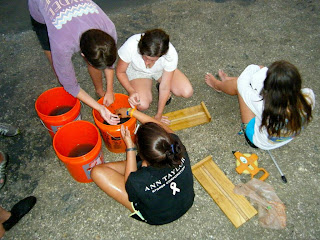On Tuesday, June 25th, we travelled to five vastly different habitats including a barrier island beach habitat, barrier beach inlets, and a coquina rock intertidal system.
The first location was a beach habitat located on the northern end of the GTMNERR. This was a characteristic barrier island beach habitat with a high wave energy. There were two rows of dunes, shown in my sketch below. The first dune was a typical dune, punctuating the end of the sandy beach, with sea oats and other small scrub dunes. Behind it, a much larger back dune rose up on a steep incline. Behind the back dune, the landscape sloped into the salt marsh.
The sand profile of the beach, also sketched below, shows a drastic stratification of finer sand, then a mix of sand and shell hash, and then heavy shell hash farthest from the waterline. The sand is stopped at the scrub dunes, due to an inhibition of sand movement and over wash.
The second location was the St. Augustine inlet, a man-made inlet shown below in a shot by Google Earth. From an aerial view, it is easy to see the man made jetties on either side of the inlet, as well as the sand deposition on one side of the jetty, and sand depletion on the other. We were told that the inlet must be constantly maintained through dredging.
 |
| St. Augustine Inlet |
The third location, the Matanzas Inlet, contrasted heavily with the St. Augustine Inlet in that it is relatively natural and devoid of human intervention. In the aerial shot, it is obvious that the flow of the water flows a much more natural pattern, and that the sand bars and consequential water flow through the area are constantly changing. Because of this, the inlet is very shallow and unpredictable.
 |
| Matanzas Inlet |
The bridge shown below near the Summer Haven community once ran over an inlet. But, upon visiting this location as our fourth stop, we saw a very different landscape. Due to sediment washout, the inlet and back river has been filling in, almost completely. Dr. Smith informed us of the discontent of the landowners in Summer Haven, who bought the property expecting to live on the water and were surprised when the river was filled and some houses were even lost due to erosion.
 |
| Summer Haven Community |
The last location was just south of Marineland where ancient coquina rock, once deep underwater, now lays exposed on the beach. This was unlike anywhere I have ever been on the east coast; the erosive forces on the coquina effectively created an intertidal community. We spent hours exploring the pools and ledges, and even found the upwelling of a spring!
 |
| Coquina Rock Formations |
 |
| A zoomed out Google Earth pictures showing the locations of the five sites relative to one another |


















































